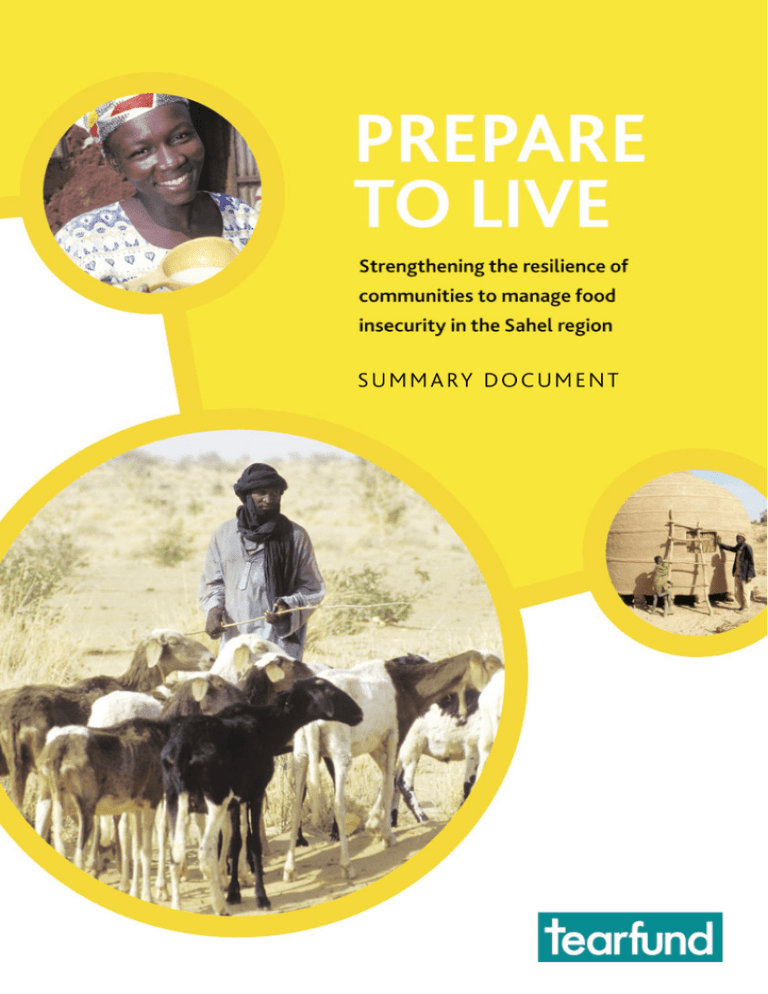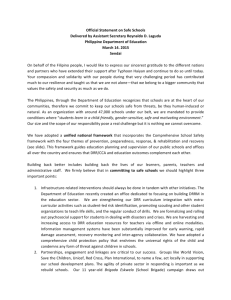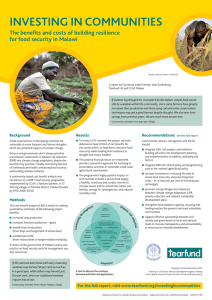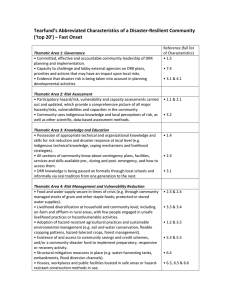S U M M A RY D O...
advertisement

S U M M A RY D O C U M E N T This is a Summary of the report: Prepare to live Strengthening the resilience of communities to manage food insecurity in the Sahel region Written by Charles Kelly and Jo Khinmaung Edited by Hazel Southam Front cover photos by Jim Loring and Andy Atkins, Tearfund Back cover photo by Caroline Kassell, Tearfund Designed by Wingfinger © Tearfund July 2007 The full report can be found at www.tearfund.org/preparetolive Tearfund is an evangelical Christian relief and development agency working with local partners to bring help and hope to communities in need around the world. In the Sahel region, Tearfund has been supporting relief, development and capacity building through local partner organisations for 25 years. Tearfund is a founding member of the Sahel Working Group, a network of British NGOs, focusing on Niger, Mali and Burkina Faso. It was formed to identify and implement solutions to the chronic vulnerability and hunger of communities, as highlighted by the 2005 food crisis. The SWG shares information, commissions research and coordinates programming and advocacy messages. Since its establishment in 1968, Tearfund has gained considerable experience in disaster management. Through programmes implemented indirectly through national partners and directly by its Disaster Management Team, Tearfund has responded in recent years to a variety of disasters including the food crisis in the Sahel in 2005. Tearfund has developed closer links between its emergency and development programming through the adoption of an integrated approach to disaster management. The primary strategy of vulnerability reduction is to increase the capacity of local communities and organisations to prevent, prepare for and respond to the impact of disasters. It is a strategy that combines changes at community level with changes to national and international policies and practices. Tearfund recognises that preventing disasters depends in part upon our ability to build just and equitable social, economic and political structures and processes, and affirms the moral duty of all people (particularly the non-poor) to accept and fulfil their responsibilities to uphold the rights and entitlements of the poorer members of our society. For further recommendations on disaster risk reduction see Tearfund’s reports Institutional donor progress with mainstreaming disaster risk reduction and Turning Practice into Policy. PREPARE TO LIV E: SU MMARY D OC U M ENT Prepare to live Strengthening the resilience of communities to manage food insecurity in the Sahel region Despite many efforts made by communities, NGOs, governments and donors, food insecurity is still a daily reality in the Sahel region in West Africa. Droughts, floods, long hunger gaps and diseases have become the norm year after year. Those who are chronically poor, in debt and lacking sufficient assets, struggle to cope effectively with these shocks. The widely variable environmental conditions increase the vulnerability of people and their livelihoods even more. Tearfund and its Sahelian civil society partners (in Niger, Burkina Faso and Mali) commissioned the report Prepare to Live to better understand how communities achieve food security and to identify practical disaster risk reduction (DRR) approaches. This means identifying ways to prevent food crises, reduce their impact and ensure that communities are prepared to cope with food insecurity. Research to inform the report was carried out through a literature review and interviews with communities, donors, governments, NGOs and other institutions in Burkina Faso, Niger, the UK and US from March to April 2007. Key messages The report highlights the following issues that are vital in helping people to escape the cycle of food insecurity in the poorest countries of the world: ■ Integration of DRR into development, relief and recovery policy and practice to improve the effectiveness and sustainability of future development efforts ■ Understanding of food security from the point of view of communities ■ The resilience of communities and their diversified strategies to manage food insecurity in the Sahel ■ Reliance on food aid and national food security stocks ■ Community participation in risk assessments, early warning systems and decisions made to address food insecurity. © TEARF U ND 2 007 1 P R E PARE TO LIV E: SU MMARY D OC U MENT Concepts Food Security The definition of food security widely used by governments, donors and NGOs focuses on a situation where: ■ a wide variety of food is available in local markets or fields (availability) ■ people have enough money to purchase a variety of foods (access) ■ food is eaten in an environment that supplies appropriate care, clean water, and good sanitation and health services (utilisation) and ■ the risk of losing these levels of availability, access, and utilisation due to shocks is low (sustainability). In contrast, work by de Waal in Sudan suggests that individuals faced with acute food insecurity may engage in actions, including foregoing immediate food consumption (ie: worsening short-term food security), to ensure an ability to produce food (as well as assure social continuity) in the future. This suggests that individual or communal views of food security may be more context-specific than the access, availability, utilisation and sustainability definition set out above. DRR Disaster risk is defined as the characteristics and frequencies of hazards experienced in a specific location, the nature of the elements at risk, and their inherent degree of vulnerability or resilience.1 DRR focuses on reducing vulnerability and the impact of hazards through: ■ mitigation – measures to minimise the impact of hazards and thus lessen the magnitude of a disaster. It also involves reducing the immediate and underlying causes of the hazard and vulnerability ■ preparedness – measures to ensure the readiness and ability of a community to forecast and take precautionary measures in advance of an imminent hazard, and to respond and cope with the effects if a disaster were to occur. DRR efforts often focus on early warning and preparing to respond to disasters. However, DRR is also preventative and when DRR is incorporated into development efforts: 1 2 ■ fewer disasters occur, and ■ when disasters do occur, damages are lower and recovery faster. Benson C, Twigg J, Rossetto T (2007), Tools for Mainstreaming DRR: Guidance Notes for Development Organisations, ProVention Consortium © T E ARF U ND 2 007 PREPARE TO LIV E: SU MMARY D OC U M ENT FIGURE 1 CY O EL D EV EME RG IE CO Destock herds Increase production of market gardens Food and cash for work Asset transfers Food aid (targeted base on assessed needs) Promote increased commercial trade in food, fodder and animals F TI G MI U TO SS RET RN RE VE EA Ongoing monitoring, assessment and information Food and cash for recovery Restock and provide inputs Small scale credit Upgrade water sources and food production capacities NE Adapted for the Sahel from The Drought Cycle (IIRR, Cordaid and Acacia Consultants) PA R Stock cereals and fodder Sell animals Increase assets (food, cash, livestock, training and connections) Identify water sources Plan for reduction in water supplies Early warning Y RL Dam and well rehabilitation Build assets Increase market garden capacities Skills training T EN Diversify livelihoods PM Increase human and animal access to health Water harvesting EN AT P RE N IO ED Possible interventions in the food insecurity cycle RY RE L Figure 1 shows examples of activities to: ■ mitigate against food insecurity by reinforcing capacities, assets and livelihoods ■ prepare people for drought or flood with reserves, assets and coping mechanisms ■ ensure that people survive a food crisis without losing too many assets ■ ensure that people recover sufficiently from the food crisis so that they are less vulnerable to future hazards. Communities should decide on appropriate activities that are adapted to the local context. The current situation in Niger and Burkina Faso 1 Disaster Risk Reduction While some efforts have been made to integrate DRR into development, relief and recovery policy and practice eg UNDP and the government in Niger, on the whole, this is limited. There seems to be little consideration of drought and flexibility to risks in the design and implementation of development projects. NGOs, governments and donors seem to lack practical tools and knowledge to incorporate DRR into project implementation (see the challenges in Table 1). © TEARF U ND 2 007 3 P R E PARE TO LIV E: SU MMARY D OC U MENT DRR EXAMPLE 1 Working with pastoralists in northern Niger P R E PA R I N G F O R D RO U G H T Since 1990, Tearfund partner JEMED has been working in the north central Niger with pastoralists to reduce their drought vulnerability. Activities include water harvesting, well digging and rehabilitation, cereal and fodder banks, improved herd management, small business development for women, education and improved healthcare. These activities are development, but also improve the ability of pastoralists to survive drought years with the least damage possible. Poor rainfall and insect damage led to poor pastures from late 2003 into 2004 in the project area. Local knowledge indicated that pastoralists would face challenges in maintaining their herds. This early warning allowed JEMED to start efforts – including destocking, increasing cereal and fodder supplies and supporting families which remained with their herds instead of migrating – to weather the impact of reduced pasture. These interventions did not prevent all the impacts of poor pasture, but did mitigate against some potentially disastrous outcomes. Conditions in 2005 were again poor, placing pastoralists at further risk of disaster. JEMED continued mitigation and relief efforts that were started in 2004 and prevented the situation from becoming considerably worse. The JEMED experience demonstrates the value of integrating disaster risk awareness and reduction efforts into long term development programming. Source: Jeunesse En Mission Entraide et Développement and Field Notes. 2 Understanding of food security Farmers, governments and often donors and NGOs focus on cereal production as the prime indicator of food security eg in early warning systems. However, this ignores the important indicators of access to food, utilisation of food and absence of shocks. It also misses the true nature of how food security is achieved. During crisis periods, more of the burden to ensure a family eats adequately falls on women. Understanding how women feed their families today and in the future will lead to more accurate assessments and management of food insecure conditions. 3 Mechanisms and community strategies to better manage food insecurity Food insecurity is fundamentally defined by communities as a lack of assets to buy cereal. Assets include funds, goods, human capacities and connections. To cope with food insecurity, communities have a range of strategies eg livestock rearing, trading and credit. They use land more intensively eg increasing the quality of pasture and fields for crops and constantly seek out opportunities to make money. These strategies change over time and location but they all aim to reduce the risk of food insecurity. 4 © T E ARF U ND 2 007 PREPARE TO LIV E: SU MMARY D OC U M ENT M I T I G AT I N G AG A I N S T F O O D I N S E C U R I T Y DRR EXAMPLE 2 Market gardens: food for today and income for tomorrow In both Niger and Burkina Faso, market gardens have become a major focus of food production diversification. Market gardens became common in Burkina Faso in the late 1970s, and in Niger after the 1984 drought. Vegetables, tubers and fruit from the gardens are sold locally and in major cities. Crops such as onions from Niger or potatoes from Burkina Faso are exported within West Africa. With access to water and capital, a grower may be able to cover his annual food needs and input costs, and have income to spare from a good market garden. For women, involvement in market gardens can also improve the quality of family food consumption. Even in years of poor rainfall, garden sites usually have water. This means that market gardening can help prepare for and mitigate against food shortages, as well as building capital for extreme crises (eg drought or illness). The importance of market gardens is poorly captured in normal food security assessments. Yet the popularity of market gardens in rural areas suggests an important contribution to addressing food insecurity, as a source of income and food. Not everyone can establish a garden. Sites with access to water are not widespread (and when available can be contested). And, as noted, access to capital is a major challenge for most people. Drawn from conversations with J Naugle, Enterprise Works/VITA, S Boubacar, and B Portier, Promotion of the Use of Agricultural Inputs by Producer Organisations Project (Niamey), and Pastor Salam Napa, Titao, Burkina Faso. At the government and donor level, the current official systems for responding to acute food insecurity are limited in scope and only partially correspond to the ways that communities manage acute food insecurity: 4 ■ The present reliance on food stocks and food aid to respond to food insecurity does not effectively address or mitigate against the impact of acute food shortages and is not sustainable. Committees allocate limited stocks with limited information, uncertainty as to future sources of food and political and financial pressures. ■ Food insecure communities are not involved in official early warning and food aid structures – eg discussing the results of the data analysis for early warning. Newly-emergent landless labourers Newly-emergent landless labourers in Niger face significant challenges to immediate and long term food security. With a reliance on seasonal agricultural income to purchase food, the newly-emergent group is particularly vulnerable to poor harvests and changing market conditions for commercial crops. Local civil society organisations, especially faith-based organisations, are well suited to supporting these individuals and families at the local level. © TEARF U ND 2 007 5 P R E PARE TO LIV E: SU MMARY D OC U MENT M I T I G AT I N G AG A I N S T F O O D I N S E C U R I T Y DRR EXAMPLE 3 Opportunities wanted: three women’s groups in Toukounous in search of ways to improve food security Toukounous is a small community north of Filingue in western Niger, dependent on herding, uncertain agriculture and trade for livelihoods. The community has three women’s groups which between them have been involved in the following food security related activities: ■ a cereal bank ■ a credit mutual ■ collecting funds for sharing by members ■ producing cheese ■ producing peanut oil (halted because peanuts cost too much to make a profit) ■ producing neibe couscous (also halted because neibe cost too much to make a profit). Individual women also collect firewood, haul water, sell cakes and other food items to fund food and other needs. The groups are now interested in seeing if they can grow and produce oil from sesame seeds, and are also looking for support to install a garden near the community. The three women’s groups pursue both a diversified strategy to meet food needs, and actively seek out new opportunities to enhance their overall food security. How can food security be improved and managed? 1 Promote and integrate DRR into development, relief and recovery Donors, governments and NGOs should: ■ Integrate DRR into development, relief and recovery policy and practice, building on previous efforts and lessons learned, especially by NGOs and UNDP (see Table 1). NGOs and other key actors (eg UNDP, ISDR and the World Bank) should: 2 ■ Organise an annual DRR roundtable to share knowledge, research and practice (drawing on local experiences) among donor, government and NGO participants. ■ Produce practical ‘hands-on’ guides on DRR to raise awareness and train development policy makers and practitioners for specific contexts in the Sahel region. Understand food security as being able to feed one’s family today and in the future Donors and governments should: ■ 6 Use the broader definition of food security which more closely aligns with the communities’ definition: access, availability, utilisation and absence of shocks in policy and practice (see the explanation of food security under Concepts). © T E ARF U ND 2 007 PREPARE TO LIV E: SU MMARY D OC U M ENT NGOs should: 3 ■ Provide testimonials and case studies on the central role which women play alongside men in assuring and improving the food security of a family. ■ Pilot projects which better target assistance to women to support their role in assuring food security. Improve mechanisms and build on community strategies to manage food insecurity Governments and donors should move towards a more diversified approach to managing harvest-to-harvest food insecurity: ■ Transfer assets to individuals, families and communities before conditions reach critical levels and after crises to facilitate recovery – eg transfers of food, cash, commodities, livestock, training, improved information flows and connections. ■ Ensure that communities are involved in risk assessments and decision making about asset transfers. ■ Ensure more effective commercial sector participation in supplying food to areas affected by shortages – eg reduction in tariffs and road taxes; strengthening linkages between commercial suppliers and early warning systems, and food crisis response planning. ■ Decentralise capacities, resources and responsibilities for relief and early warning systems that are participative and focus on the potential disaster victim. These efforts should link with ongoing improvements in early warning systems in Niger and Burkina Faso (eg by FewsNet, CILSS, FAO, WFP and CARE Niger). NGOs should support governments and donors in the recommendations above by: 4 ■ Piloting new and different ways to respond to food crises as they arise – eg targeted cash transfers, vouchers for agricultural inputs, and training to improve short term income opportunities. ■ Documenting options to manage food insecurity, including recent experiences with cash payments in Tanout, Niger, and cash for work. ■ Involving communities more in decision making on how to address food insecurity Support landless labourers NGOs in Niger, especially faith-based organisations, should: ■ Support targeted individuals and families most at risk of food insecurity, due to the emergence of a landless labourer class. For example, with education and skills training by which the vulnerability of this group can be reduced over the long term. © TEARF U ND 2 007 7 P R E PARE TO LIV E: SU MMARY D OC U MENT TABLE 1 Integrating DRR into development, relief and recovery Challenges Proposed solutions Other urgent priorities and rapid response to disasters leave limited time for DRR. Integrate DRR into the development project cycle, including specific DRR outputs, activities and indicators in logical frameworks, implementation, monitoring and evaluation. Before a disaster, identify possible DRR activities that can be integrated into relief and recovery and build capacity to manage disasters. Make integrated DRR a requirement in funding proposals and assess how ongoing activities are likely to reduce the impact of future disasters. Lack of awareness of the impact of disasters and ways to reduce future risk. Disseminate reporting on the impact of disasters and the ways that DRR can reinforce development and reduce spending on disaster response. Identify, analyse and address emerging risks – eg a deteriorating drought situation – in project design and implementation with community-based risk assessments. See Tearfund’s Participatory Assessment of Disaster Risk Tool (Venton and Hansford) and the Disaster Risk Review table in Section 2.1 in the full version of this report. Develop a catalogue of options and train staff on practical and successful ways that DRR can be integrated into development, relief and recovery – eg through UN OCHA and the Humanitarian Information Centre during disasters. DRR is seen as the responsibility of disaster managers in emergency units. Assign or second DRR advisers to build capacity and support the incorporation of DRR into development projects and staff’s job descriptions, including training. Difficulty in linking DRR and development outcomes. Ensure that projects have the flexibility to respond to hazards during the course of a development project. Link project activities to existing community risk management efforts and include communities in the design of development projects to ensure that they address vulnerability appropriately. Ensure that funding allows relief and recovery interventions to reduce future vulnerability rather than simply returning to pre-disaster conditions. 8 © T E ARF U ND 2 007 Authors Charles Kelly has worked on food security issues in the Sahel and elsewhere for over 12 years, and has published several articles on disaster management. He is a Senior Fellow at the Cuny Centre, and an affiliate of the Benfield UCL Hazard Research Centre, University College London (the views represented in the report do not necessarily reflect those of the Cuny Centre or the Benfield UCL Hazard Research Centre). Jo Khinmaung is Public Policy Officer in the West Africa Team at Tearfund. Contact: jo.khinmaung@tearfund.org Acknowledgements We would like to acknowledge the contributions of all who took part in developing this report, including Tearfund’s partners, other NGOs, government and donor officials interviewed. In particular: Abdoul-Azize Sarki and Siman Assoumane Issa from UEEPN and Jeff Woodke from JEMED in Niger; Ardiouma Hema and Dieudonné Kafando from CREDO and Dieudonne Bargo from ODE in Burkina Faso. Thanks also to those who commented on drafts of the report. www.tearfund.org 100 Church Road, Teddington, TW11 8QE, United Kingdom Tel: +44 (0)20 8977 9144 Registered Charity No. 265464 18252–(0607)



